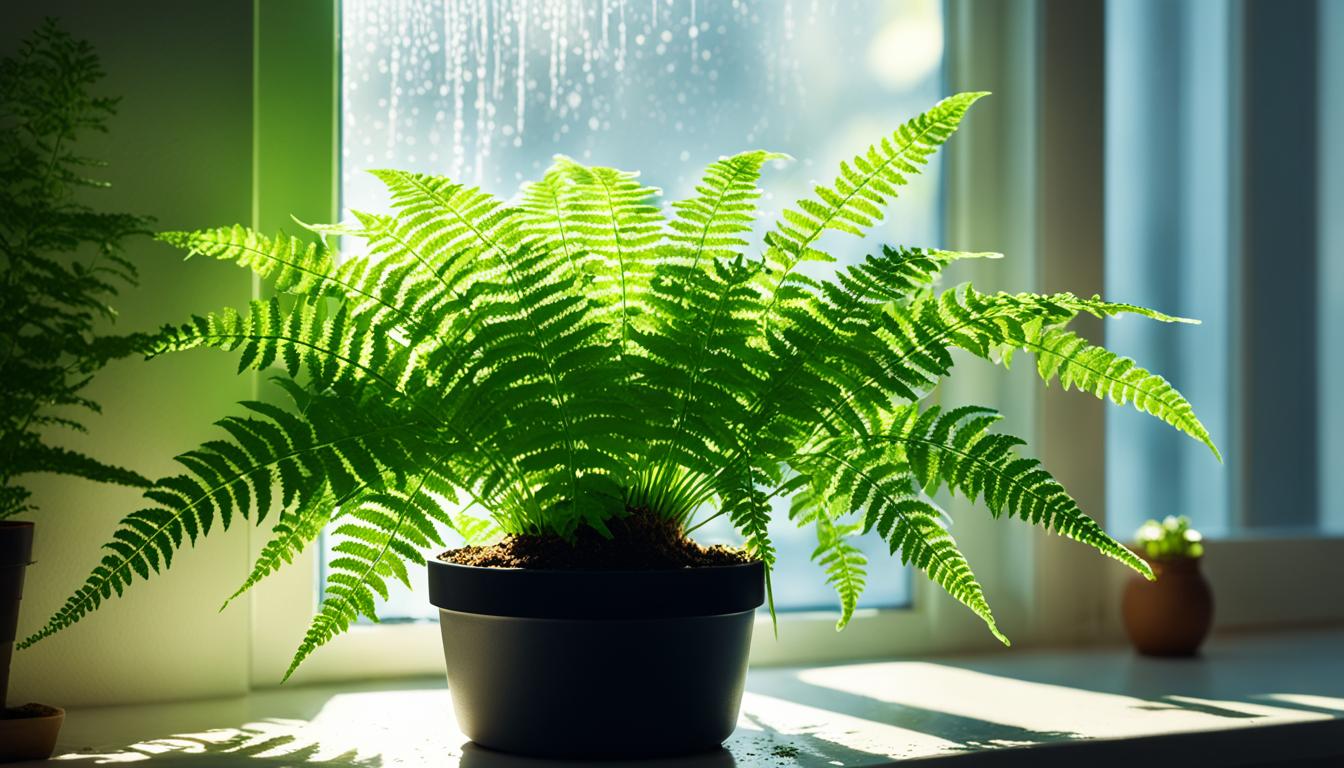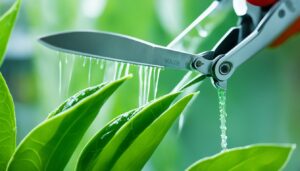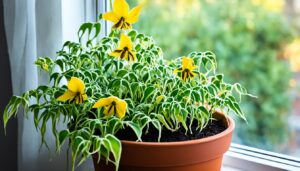Have you ever wondered how to successfully cultivate lush, green ferns indoors? Indoor ferns can add a touch of exotica and elegance to any home, providing lushness and texture that make them a popular choice for houseplant enthusiasts. While ferns require specific care, they are generally easy to maintain if their needs are met. In this comprehensive guide, you’ll discover everything you need to know about cultivating ferns indoors, from understanding ferns and choosing the right one for your home, to essential care tips and troubleshooting common problems.
Introduction
Welcome to the world of indoor ferns! As a houseplant enthusiast, you know the joy that comes from nurturing and caring for these lush and exotic plants. Indoor ferns have a long history of cultivation, dating back to the Victorian era, and they continue to captivate plant lovers today. Their graceful fronds and vibrant green foliage bring a touch of nature and a sense of tranquility to any room.
While caring for indoor ferns requires some attention to detail, the rewards are well worth the effort. In this comprehensive guide, we will provide you with all the information you need to care for indoor ferns like a pro. From understanding fern varieties and selecting the right one for your home, to essential care tips and troubleshooting common problems, this guide will equip you with the knowledge to keep your ferns thriving.
Understanding Ferns
Ferns are a diverse and fascinating group of plants that make excellent choices for indoor cultivation. With their delicate foliage and unique growth habit, ferns can bring a touch of natural elegance to any indoor space. In this section, we will explore the different varieties of ferns that thrive indoors, discuss their distinctive characteristics, and take a closer look at their anatomy.
Fern Varieties
There are numerous fern varieties that can be successfully grown indoors. Some of the popular choices include:
- Boston Fern (Nephrolepis exaltata): Known for its graceful and feathery fronds, the Boston Fern is one of the most popular indoor ferns.
- Maidenhair Fern (Adiantum spp.): With their delicate, fan-shaped fronds, Maidenhair ferns create a beautiful and airy display.
- Rabbit’s Foot Fern (Davallia spp.): This unique fern variety gets its name from the furry rhizomes that grow above the soil.
Each fern variety has its own distinct charm and care requirements, so it’s important to choose one that suits your indoor environment.
Fern Characteristics
Ferns are characterized by their feathery or lacy fronds and their ability to reproduce through spores. Unlike flowering plants, ferns do not produce seeds or flowers. Instead, they have specialized structures called rhizomes, which serve as a storage organ and help ferns spread and multiply.
Fern Anatomy
The anatomy of ferns is unique and intriguing. Let’s take a closer look at the key parts of a fern:
- Fronds: Fronds are the leafy structures of ferns. They emerge from the rhizome and can vary in shape, size, and texture depending on the fern variety. Fronds can be divided into two main parts: the stipe (or leaf stalk) and the blade (the expanded leaf portion).
- Rhizomes: Rhizomes are the underground stems of ferns. They play a vital role in fern growth, anchoring the plant in the soil and storing nutrients. Rhizomes also produce new fronds and can spread horizontally, giving rise to new ferns.
Understanding the anatomy of ferns will help you appreciate their unique structure and better care for these captivating plants.
Choosing the Right Fern for Your Home
When selecting a fern for your indoor space, it’s important to consider the specific needs and conditions of your home. Different fern varieties have varying preferences for light conditions, making it essential to choose a fern that will thrive in your environment. Here’s a guide to help you select the best fern for your indoor space:
When it comes to light conditions, some ferns prefer indirect light, while others can tolerate brighter light. Here are a few examples:
- Boston Fern: This popular houseplant enjoys bright, indirect light and thrives in high humidity.
- Staghorn Fern: Staghorn ferns are unique and can tolerate brighter light. They make a stunning statement when mounted on walls or displayed on plaques.
- Maidenhair Fern: Maidenhair ferns prefer lower light conditions and thrive in a slightly more humid environment.
Aside from light conditions, there are other factors to consider when selecting ferns for your indoor space. Size is an essential consideration, as some ferns can grow quite large, while others stay more compact. It’s essential to choose a fern that fits well within the available space in your home.
Ferns also have varying growth habits, with some having an upright growth pattern, while others spread out. Consider the growth habit of the fern you choose to ensure it matches your aesthetic preferences and fits well with your existing home decor.
Additionally, caring for ferns may require varying levels of attention and maintenance. Consider the specific care requirements of the fern you’re interested in and ensure it aligns with your availability and willingness to care for the plant.
By considering these factors, such as light preferences, size, growth habit, and care requirements, you can choose the perfect fern for your indoor space. Whether you opt for a lush Boston fern or a unique staghorn fern, adding ferns to your home will bring a touch of natural beauty and elegance to any room.
The Essentials of Indoor Fern Care
Proper care is crucial for maintaining the health and beauty of your indoor ferns. By following these essential care tips and guidelines, you can ensure that your ferns thrive and flourish in your home.
1. Light Requirements:
Indoor ferns prefer bright, indirect light. Place your ferns near a north or east-facing window to provide them with the right amount of light. Avoid placing them in direct sunlight, as it can scorch their delicate foliage.
2. Watering Needs:
Ferns thrive in moist conditions, so it’s important to keep the soil consistently moist but not waterlogged. Water your ferns when the top inch of soil feels slightly dry. Use room temperature water to avoid shocking the plants.
3. Humidity Considerations:
Indoor ferns appreciate high humidity levels. To increase humidity, you can mist the ferns’ fronds with water regularly or place a humidifier nearby. You can also create a humidity tray by filling a shallow tray with water and placing pebbles in it. Ensure that the bottom of the pots is not sitting directly in water to prevent root rot.
4. Soil and Potting:
Ferns prefer well-draining, rich, and slightly acidic soil. Choose a high-quality potting mix that is specifically formulated for indoor plants or create your own by combining equal parts peat moss, perlite, and vermiculite. Repot your ferns every 1-2 years to prevent overcrowding and provide fresh soil.
5. Temperature and Air Circulation:
Keep your ferns in a temperature range of 65-75°F (18-24°C) during the day and slightly cooler at night. Avoid exposing them to cold drafts or extreme temperatures. Good air circulation is also important for ferns, as stagnant air can lead to fungal issues. Place them in a well-ventilated area.
6. Fertilizing and Pruning:
Feed your ferns with a balanced liquid houseplant fertilizer once a month during the growing season (spring and summer). Prune any yellowed or damaged fronds regularly to maintain the overall health and appearance of the plant. You can also divide mature ferns to propagate new plants.
Remember, each fern species may have slightly different care requirements, so it’s important to research the specific needs of your fern variety. With proper care and attention, your indoor ferns will reward you with their lush, vibrant foliage.
| Aspect of Care | Guidelines |
|---|---|
| Light Requirements | Place ferns in bright, indirect light |
| Watering Needs | Keep soil moist but not waterlogged; water when top inch of soil is slightly dry |
| Humidity Considerations | Maintain high humidity through misting or using a humidifier |
| Soil and Potting | Use well-draining, rich, slightly acidic soil; repot every 1-2 years |
| Temperature and Air Circulation | Maintain a temperature range of 65-75°F (18-24°C); provide good air circulation |
| Fertilizing and Pruning | Fertilize monthly with balanced liquid houseplant fertilizer; prune yellowed or damaged fronds |
Light Requirements
Indoor ferns may be associated with shady areas in the wild, but they still need some light to thrive indoors. Understanding the best light conditions for ferns is essential for their optimal growth and health.
To provide the right lighting for your indoor ferns, aim for dappled light or indirect light near a window. This type of lighting mimics the filtered sunlight ferns receive in their natural habitats. It allows them to photosynthesize and produce energy while avoiding direct sunlight that can burn their delicate foliage.
Avoid placing your ferns in areas with strong, direct sunlight, especially during the hottest parts of the day. It’s important to protect them from intense rays that can scorch their leaves. If you have a particularly sunny spot in your home, consider using sheer curtains or blinds to filter the light and create a more suitable environment for your ferns.
Remember that each fern variety may have slightly different light requirements. Some ferns, such as the Boston fern, prefer bright indirect light, while others, like the bird’s nest fern, can tolerate lower light conditions. Refer to specific care guidelines for the fern variety you have to ensure you provide the best lighting conditions for its needs.
Watering Needs
Proper hydration is essential for the health and vitality of indoor ferns. By understanding their watering needs, you can ensure that your ferns thrive and continue to beautify your home. Here are some important guidelines to keep in mind:
- Moist, not Soggy: Ferns prefer to be kept in moist soil, but they do not tolerate waterlogged conditions. Overwatering can lead to root rot and other issues. It’s crucial to strike the right balance and avoid letting the soil dry out completely between waterings.
- Check Soil Moisture: Before watering your fern, check the moisture level of the soil. Insert your finger about an inch deep into the soil. If it feels dry, it’s time to water. If it feels moist, wait a little longer.
- Adjust Watering Frequency: The frequency of watering depends on various factors, including temperature and light exposure. During warmer months, ferns may require more frequent watering than in cooler months. Observe your ferns closely and adjust the watering schedule accordingly.
- Room Temperature Water: When watering your ferns, it’s best to use room temperature water. Water that is too cold or too hot can shock the roots and adversely affect plant health. Allow tap water to sit out overnight to dissipate any chlorine before using it on your ferns.
By adhering to these watering guidelines, you can provide your indoor ferns with the proper hydration they need for optimum growth and beauty.
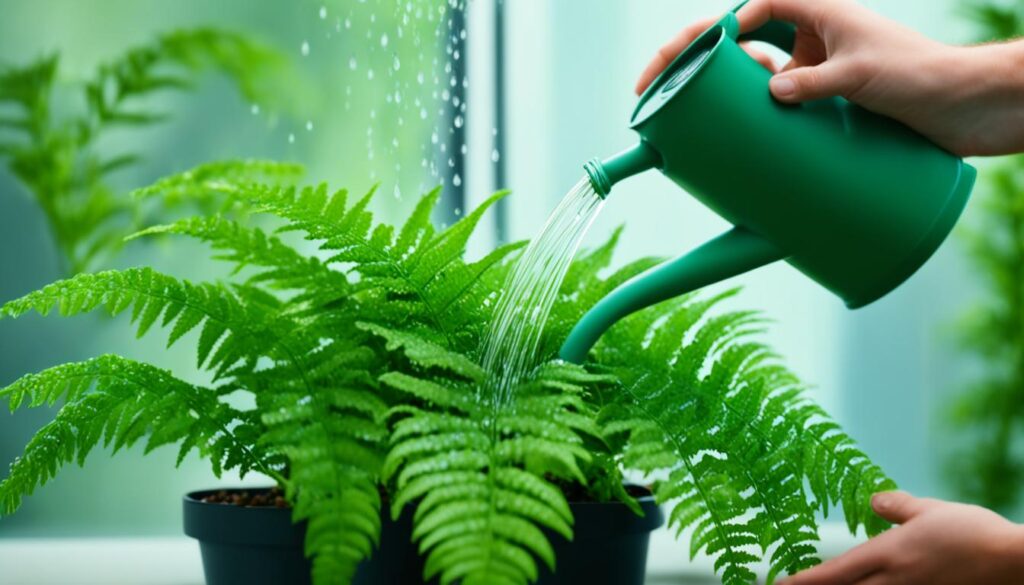
Humidity Considerations
Proper humidity is crucial for the health and growth of indoor ferns. As tropical plants, ferns prefer moderately high humidity levels, which can be challenging to maintain in the average home environment, especially during the winter months.
When the humidity drops too low, it can cause the fronds of ferns to brown and yellow, and the overall health of the plant may deteriorate. To ensure optimal humidity levels for your indoor ferns, consider the following tips:
- Use a humidifier: A humidifier is an excellent investment for creating a moist environment that mimics the natural conditions ferns thrive in. Position the humidifier near your ferns to provide consistent moisture.
- Mist the leaves: Regularly misting the leaves of your ferns with water can help increase humidity levels in the immediate vicinity. Use room-temperature water to avoid shocking the plants.
- Place on a humidity tray: Placing your ferns on a humidity tray filled with water and pebbles can create a microclimate with higher humidity around the plants. As the water evaporates, it raises the humidity level.
- Group ferns together: Grouping multiple ferns together can create a mini greenhouse effect by trapping moisture released through transpiration. This helps maintain higher humidity levels around the plants.
In addition to these measures, it’s essential to monitor the humidity levels regularly. Invest in a hygrometer to keep track of the humidity in the room where your ferns are located. This way, you can make adjustments as needed to maintain optimal humidity for your indoor ferns’ health and well-being.
Soil and Potting
Proper soil and potting are crucial for the health and growth of indoor ferns. Ferns prefer humus-rich and slightly moist soil that provides the right balance of nutrients and moisture retention.
When it comes to potting mixes, there are several options available. Commercially available potting soils specially formulated for ferns can be a convenient choice. These mixes often contain organic matter, such as peat moss or compost, which helps retain moisture and promote healthy root development.
If you prefer a DIY approach, you can create your own soil mixture by combining equal parts of peat moss, perlite, and compost. This homemade mixture provides good drainage while retaining enough moisture for ferns to thrive.
When potting ferns, it’s important to choose a container with drainage holes to prevent waterlogging. This allows excess water to escape, avoiding root rot. Fill the pot with the potting mix, leaving enough space for the fern’s roots. Gently place the fern in the pot, ensuring the roots are spread evenly. Backfill the remaining space with the potting mix, pressing it gently to secure the fern in place.
Repotting ferns is necessary when they outgrow their containers. Signs that your fern needs repotting include roots becoming cramped or growing out of the drainage holes. To repot, gently remove the fern from its current pot, loosen the root ball to stimulate new root growth, and place it in a slightly larger container with fresh potting mix. Remember to water the fern thoroughly after repotting to help it settle into its new home.
| Soil | Potting | Repotting |
|---|---|---|
| Humus-rich | Choose a container with drainage holes | When the fern outgrows its current pot |
| Slightly moist | Fill the pot with potting mix, spread fern’s roots, backfill | Loosen root ball, place in larger pot, water thoroughly |
Temperature and Air Circulation
Indoor ferns have specific temperature preferences to thrive and grow. The optimal temperature range for ferns is typically between 65-75°F during the day, with slightly cooler temperatures at night. It is important to provide ferns with a moderate and consistent temperature to ensure their well-being.
To maintain the optimal temperature for your indoor ferns, avoid exposing them to extreme temperatures, such as drafts from windows or doors. Ferns are susceptible to temperature fluctuations, which can stress the plants and hinder their growth. Keep your ferns away from heating or cooling vents to prevent sudden temperature changes.
Adequate air circulation is also crucial for the health of indoor ferns. Stagnant air can create a breeding ground for fungal infections and other issues. To promote air circulation, you can place a small fan near your ferns on a low setting. This gentle airflow will help prevent the buildup of moisture and keep the foliage dry, reducing the risk of fungal problems.
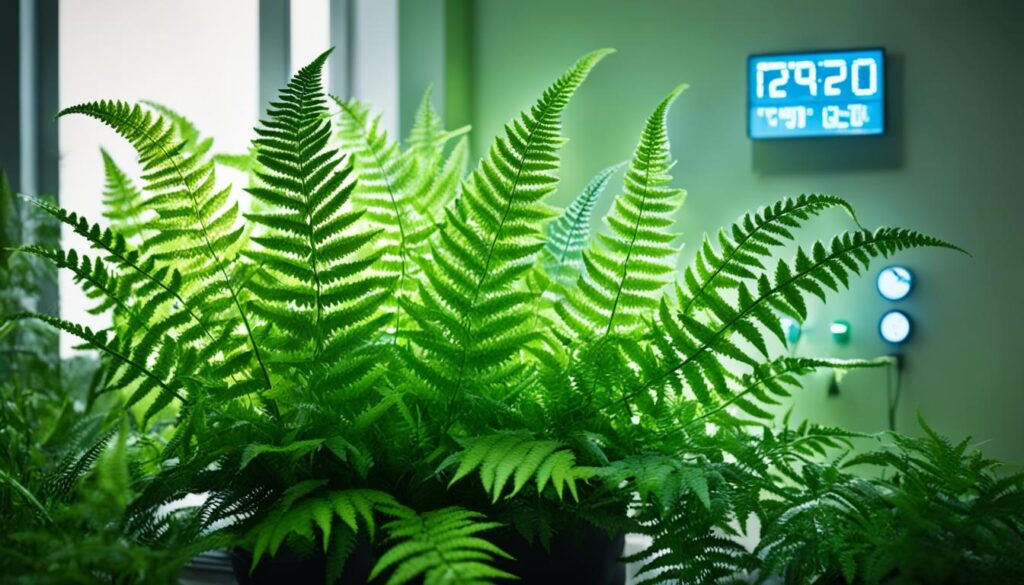
Fertilizing and Pruning Your Ferns
Proper fertilizing and pruning are essential for maintaining the health and vitality of your indoor ferns. By providing the right nutrients and removing any damaged or dead fronds, you can help your ferns thrive and continue to beautify your home.
“Fertilizing is a key aspect of indoor fern care as it ensures that your ferns receive the necessary nutrients for growth and development.
Fertilizing Your Ferns:
When it comes to indoor fern fertilizing, a balanced liquid houseplant fertilizer is recommended. This type of fertilizer provides essential nutrients like nitrogen, phosphorus, and potassium, which are necessary for healthy fern growth. It is best to follow the instructions provided by the manufacturer for the specific fertilizer you are using.
During the growing season, which typically spans spring and summer, fertilize your ferns every two to four weeks. Be careful not to over-fertilize as this can lead to salt buildup in the soil, causing damage to the fern’s roots. Always water your ferns before applying fertilizer to prevent the roots from getting burnt.
“Pruning your ferns is crucial to maintain their overall health and appearance. Regular pruning helps remove dead or damaged fronds and promotes new growth.”
Pruning Your Ferns:
To prune your ferns, start by identifying any fronds that are discolored, dried out, or damaged. Use clean, sharp pruning shears or scissors to carefully remove these fronds at the base, close to the main stem. Be sure not to remove any healthy fronds during the pruning process.
In addition to removing dead or damaged fronds, you can also prune your ferns to control their size and shape. Trimming back overgrown fronds can help maintain a compact and tidy appearance. If you notice any runners or side shoots, you can prune and propagate them to create new ferns through division.
Remember, always sanitize your pruning tools before and after each use to prevent the spread of diseases.
By regularly fertilizing and pruning your indoor ferns, you can ensure their long-term health and enjoy their natural beauty in your home.
Troubleshooting Common Fern Problems
Indoor ferns can be a delightful addition to any home, but they can sometimes encounter problems. In this section, we will address common fern problems, including pests, diseases, and environmental issues. With these troubleshooting tips, you’ll be able to keep your ferns healthy and thriving.
Low Moisture and Humidity Levels
All ferns require moist soil and moderate to high humidity levels to thrive. If you notice your fern’s fronds turning brown or drying out, it may be due to low moisture and humidity levels. To address this issue, follow these tips:
- Water your fern regularly, ensuring that the soil remains consistently moist, but not waterlogged.
- Mist the leaves of your fern with water daily to increase humidity around the plant.
- Group your ferns together or place them on a pebble tray filled with water to create a humid microclimate.
Fern Pests and Diseases
Just like any other plant, ferns can fall victim to pests and diseases. Common pests that may affect ferns include scale insects and spider mites. Diseases that can impact ferns include fungal infections and root rot. If you notice any signs of pests or diseases, take the following actions:
- Inspect your fern regularly for signs of pests, such as small insects or webs.
- If you spot pests, gently wipe the leaves with a damp cloth or use an organic insecticidal soap.
- To prevent fungal infections, avoid overwatering and provide good air circulation around your fern.
- If your fern shows signs of root rot, repot it in fresh, well-draining soil and remove any affected roots.
Remember to maintain good hygiene practices by keeping your fern clean and free from dead or decaying plant debris, as this can attract pests and encourage disease.
If you follow these troubleshooting tips, you’ll be able to address common fern problems and ensure the health and vitality of your indoor ferns.
Decorating with Ferns: Creative Ideas
Ferns are not only beautiful houseplants but also versatile decorative elements that can enhance the overall aesthetic of your home. Incorporating indoor ferns into your interior design can add a touch of elegance and natural beauty to any space. Here are some creative ideas to inspire you in decorating with ferns:
1. Hanging Baskets: Hang ferns in decorative baskets and suspend them from the ceiling or hooks on the wall. This not only adds visual interest but also saves valuable floor space.
2. Terrariums: Create a mini fern ecosystem in a glass terrarium. Fill it with a layer of soil, decorative rocks, and moss, and then place your fern inside. Terrariums provide a unique and captivating display of ferns while also creating a microclimate that retains moisture.
3. Mounted Ferns: Mount ferns on a piece of driftwood or moss-covered board to create a stunning wall display. This adds a natural, rustic charm to your home and allows you to showcase the unique foliage of different fern varieties.

4. Fern Arrangements: Combine ferns with other complementary plants to create eye-catching arrangements. Pair them with prayer plants, spider plants, or bromeliads for a vibrant and lush display.
5. Fern Terraces: Arrange ferns on different height shelves or plant stands to create a tiered effect. This not only adds dimension to your space but also ensures that each fern receives adequate light.
6. Fern Bookends: Place potted ferns on either side of your bookshelf to serve as stunning and unique bookends. This adds a touch of greenery and sophistication to your reading nook or home office.
7. Fern Chandeliers: Create a captivating focal point in your living room or dining area by hanging ferns in decorative hanging planters from a stylish chandelier. This creates a whimsical and enchanting atmosphere.
Get creative with your indoor fern displays and let your imagination guide you. Experiment with different containers, textures, and combinations to create unique and personalized fern decor. Remember to provide the appropriate care and maintenance to keep your ferns looking their best.
Fern Care Myths Debunked
When it comes to caring for indoor ferns, there are many common myths and misconceptions that can lead to confusion and frustration. It’s time to set the record straight and debunk these fern care myths once and for all. By understanding the facts and science behind fern care, you can provide your indoor ferns with the proper care they need to thrive.
Myth 1: Ferns require constant misting
Contrary to popular belief, ferns do not require constant misting to thrive. While ferns appreciate humid environments, misting alone is not sufficient to meet their humidity needs. Instead, focus on providing indirect light, maintaining proper watering habits, and using alternative methods such as humidity trays or a room humidifier to maintain the ideal humidity level for your ferns.
Myth 2: Ferns are finicky plants that are difficult to care for
While ferns do have specific care requirements, they are not inherently difficult to care for. With a basic understanding of their needs and a little attention to detail, you can successfully care for indoor ferns. By providing the right light conditions, proper watering, adequate humidity, and suitable soil, you can create an environment in which your ferns can flourish.
Myth 3: Ferns cannot tolerate low light conditions
While it’s true that ferns thrive in indirect light, not all ferns require bright, direct sunlight. There are many fern varieties that can tolerate lower light conditions, making them suitable for rooms with limited natural light. By choosing ferns that are well-suited for low light environments, such as the Bird’s Nest Fern (Asplenium nidus), you can enjoy the beauty of ferns even in areas with less sunlight.
Myth 4: Ferns are high-maintenance plants
Another misconception about ferns is that they are high-maintenance plants. In reality, once you understand their basic care requirements and provide them with the right conditions, ferns are relatively low-maintenance. By following the essential care tips for indoor ferns, such as providing the right light, humidity, and watering, you can ensure the health and vitality of your ferns with minimal effort.
Now that the myths have been debunked, you can confidently care for your indoor ferns using facts and evidence-based information. By understanding the truth about fern care and providing your plants with the right conditions, you can enjoy the beauty and benefits of having thriving ferns in your home.
Conclusion
Congratulations! You’ve now reached the end of this comprehensive guide to indoor fern care. Let’s recap the key takeaways:
- Understanding Ferns: You’ve learned about the different varieties of ferns and their unique characteristics.
- Choosing the Right Fern: You now know how to select the perfect fern for your home based on light conditions and other factors.
- The Essentials of Indoor Fern Care: You have a solid foundation of knowledge on how to care for ferns, including light requirements, watering needs, humidity considerations, soil and potting guidelines, as well as temperature, air circulation, fertilizing, and pruning techniques.
- Troubleshooting Common Fern Problems: You’re equipped with troubleshooting tips to address issues like low moisture, pests, and diseases that can affect your ferns.
- Decorating with Ferns: You’ve discovered creative ideas to incorporate ferns into your interior design, enhancing the aesthetics of your home.
- Fern Care Myths Debunked: You can confidently distinguish between fact and fiction when it comes to caring for your ferns, ensuring their overall well-being.
By applying the knowledge you’ve gained from this guide, you’ll be able to create a thriving indoor fern oasis that brings beauty and a touch of nature to your living spaces. Remember to tailor your care to each fern’s specific needs and continue exploring the endless possibilities of indoor fern decor.
Final Thoughts on Indoor Ferns
Indoor ferns are not just plants, they are living works of art that can transform your home into a lush paradise. With their delicate foliage and graceful presence, ferns add an exotic touch and create a serene ambiance.
The key to successful indoor fern care lies in understanding their unique requirements and providing them with the right conditions. From choosing the right fern for your space to ensuring proper light, water, and humidity levels, each aspect of care plays a crucial role in their overall well-being.
Remember to regularly check your ferns for signs of stress or issues and take prompt action to address them. With patience, care, and a little bit of green-thumb magic, you’ll be rewarded with thriving ferns that bring joy and beauty to your home for years to come.
Call to Action
Ready to bring the beauty of indoor ferns into your home? It’s time to explore and purchase your own indoor ferns to create an oasis of greenery. Whether you’re a beginner or an experienced houseplant enthusiast, adding ferns to your collection will elevate the ambiance of any room.
Looking to buy indoor ferns online? You’re in luck! There are several reputable online plant retailers that offer a wide selection of indoor fern varieties. Check out websites like Plantify, The Sill, and Bloomscape for a range of options to suit your taste and style.
If you prefer to find indoor ferns near you, visit local plant nurseries, garden centers, or even specialty shops that specialize in indoor plants. These establishments often carry a variety of ferns that are well-suited to your local climate and growing conditions.
Ready to shop for indoor ferns and start your indoor fern care journey? Don’t miss out on the opportunity to bring the elegance and vibrancy of ferns into your home. Start creating your own indoor fern oasis today!
FAQ
Do ferns need direct sunlight?
No, ferns do not thrive in direct sunlight. They prefer bright, indirect light or dappled light near a window.
How often should I water my indoor fern?
It is important to keep the soil moist but not soggy. Water your fern when the top inch of soil feels dry, adjusting the frequency based on temperature and light exposure.
What type of soil is best for indoor ferns?
Ferns prefer humus-rich and slightly moist soil. Use a well-draining potting mix, such as commercially available potting soils or homemade soil mixtures.
Should I mist my indoor fern?
Misting is not necessary for ferns. Instead, increase humidity by using a humidifier, misting the leaves with water, or placing the plant on a humidity tray.
How often should I fertilize my indoor fern?
Fertilize your fern every 2-3 months during the growing season with a balanced liquid houseplant fertilizer, following the package instructions.
How do I prune my indoor fern?
Remove any damaged or dead fronds by cutting them at the base. To propagate your fern, divide the plant using a sharp, clean knife or shears.
What are common problems that ferns face?
Common problems include low moisture and humidity levels, pests like scale and spider mites, and diseases such as fungal infections. Adjusting watering and humidity levels, using appropriate pest control methods, and maintaining good hygiene practices can help address these issues.
How can I decorate with ferns?
Get creative with fern displays by using hanging baskets, terrariums, or mounted ferns as focal points. Consider pairing ferns with companion plants like prayer plants, spider plants, or bromeliads.
Are ferns difficult to care for?
While ferns have specific care requirements, they are generally easy to maintain with proper knowledge and attention to their needs. Understanding their light, water, and humidity preferences will empower you to successfully care for your indoor ferns.
Where can I buy indoor ferns?
You can purchase indoor ferns online or locally at garden centers, plant nurseries, and home improvement stores. Check websites specializing in indoor plants or visit nearby establishments to find a wide variety of fern options.


